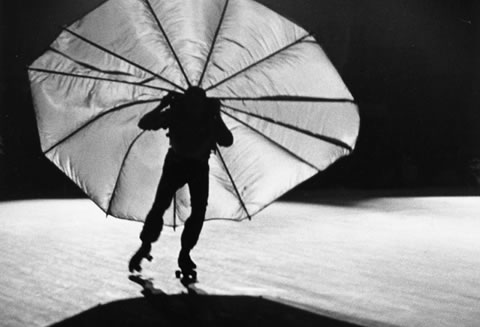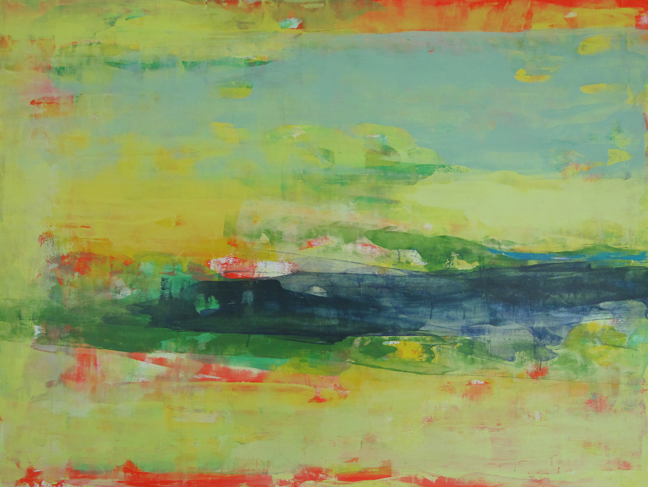The eye intuitively seeks out a horizon in Palermo, a painting by Regina Tumasella. As layers of vibrant color roll across rectangular planes, one is immersed in a faraway place with ample space to roam. Kenduskeag, another painting currently on display at School 33, in Stroke: Gesture, Mark, Muscle, evokes a late winter afternoon where cool, aqua blues and greens play against streaks of red-oranges, spreading a fiery warmth and depth across a perceived sky. A subtly concave band of grays and mature blue-greens create the weight of land and shadow just above the midpoint of the canvas. While the artist acknowledges her paintings can be comfortably entered as landscapes, through horizontal planes and place-based titles, Regina Tumasella is more interested in exploring time and space through her work than a specific place.
Originally from New York’s Catskill mountains, Tumasella has made her home in Baltimore for over 15 years. Unlike most painters, the artist uses a wide brayer, traditionally a printmaking tool, to apply swaths of acrylic paint to large canvases or board. Tumasella’s artistic practice welcomes the unexpected without preconceived ideas of the finished product, and she allows layers upon layers of color create lines, occasional drips, and unexpected combinations.
The artist describes her process of painting as focused and meditative, dwelling in memory and emotion. Although her works celebrate experimental combinations of color, certain themes in palette clearly emerge when viewing a large body of work. A signature hand mixed aqua green typically dominates, contrasting with glimpses of orange variations. Tumasella is intuitively attracted to this color, and connects it to water and sky, while she attributes the warm tones to energy. Although her earlier paintings use a lot of white, creating a cool opacity and subtlety, her newer paintings reveal more of the history beneath, with pure, bold surface colors with layers she describes as ‘wet’ and flowing. It also appears that Tumasella’s work is growing progressively warmer, from a more conservative use of selective slivers of heat, to bolder contrasts where red-oranges and oranges are allowed to stretch and breathe in broad, bold planes.
In contrast to her vibrant acrylic paintings, the artist also explores graphic mark making and architectural structure through her newest drawings. Using the square tips of graphite sticks on paper, Tumasella creates quirky quarter-inch squares that become singular units making up spontaneous organic forms. Using a range of values, Tumasella creates variation even within one unique, tiny square. The resulting combination is visually rippling, and creates a sense of trailing movement. Beginning at the very top of the paper, the artist works across and down in an intuitive process, finishing each piece in one or two sittings of several hours. The precarious smudging nature of the material dictates careful, focused concentration. These drawings are only numbered, leaving the viewer without any narrative clues. Groups of linear blocks dangle like marionettes, and stiffly curve to provoke a response through their proximity to the neighboring forms.
The hundreds of small tiles in her drawings are a curious departure from the broad colorful bands of her paintings, although both employ a somewhat automatic process. The artist described alternating between media as restorative, that the focus on black and white gave her a fresh eye for color. The immediacy of the works on paper sit close to the surface, in contrast to the vast space and depth in the layers of her paintings. While the paintings are an exploration of color, the drawings are an exploration of composition and mark making. It will be interesting to see what effect the experimental drawings have on her paintings, or if Tumasella will eventually give titles to the drawings, developing them as thoroughly as her painted works.
At School 33, Tumasella’s three pieces hang in an interior gallery along one spot-lit wall. Experiencing them, I wanted a bench to sit and wander through the distinct topography, time of day, and seasons they quietly evoke. When titling her paintings, the artist scans New England atlases for names of towns that she finds compelling. They are usually names that are reused and repeated around the country, or even around the world. This repetition of name and landscape convey the relationship between individuality and universality, both in landscape and the human experience. While this concept is engaging, it is also a place to pause. The abstract landscapes, after all, are not portraits of particularly named places, they exist on the canvas by chance in the artist’s method. Although arbitrarily assigned, the titles provide an anchor for viewers to attach a particular way of viewing, and also allude to the subjective nature of remembering a place.
During a studio visit, I wanted to dig deeper. I wanted to discover a longer, more specific story to help me relate more to the work. What are the origins of that aqua green? Where do all those little squares come from, and what are they saying to each other? As a writer, I was filled with questions that the artist has no need to answer.
Is it enough for me to appreciate Tumasella’s work on a purely aesthetic level? When I saw her work in the gallery, it quieted my internal chatter. The lack of narrative and cerebral thought became more and more refreshing and inspiring. The meaning of each work is revealed through unselfconscious layers of paint and carefully, accidentally built compositions. There is ample space to react, project emotion, or to simply visually wander.
More of Regina Tumasella’s work can be seen at reginatumasella.com
Paintings currently on display at School 33, Stroke: Gesture, Mark, Muscle, through December 29th
Drawings currently on display at Howard County Arts Council Gallery, Art Maryland 2012, through December 14th
Author: Jill Gordon is an urban explorer, fiber artist, and writer who is both enamored and bewildered by the grit and vitality found in her fair city. She is a member of Mother Made Baltimore, www.mothermadebaltimore.org, and can be contacted at [email protected].










